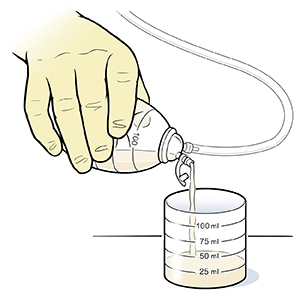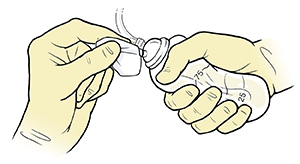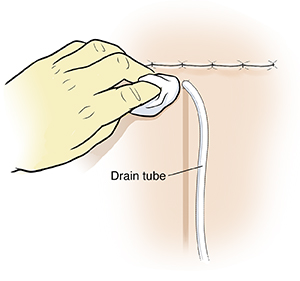Caring for a Closed Suction Drainage Tube
Caring for a Closed Suction Drainage Tube
A drainage tube removes fluid from around an incision. This helps prevent infection and promotes healing. The collection bulb at the end of the tube is squeezed and plugged to create suction. The bulb should be emptied and reset when half full to maintain adequate suction. You need to empty the bulb and clean the skin around the drain as often as your healthcare provider tells you to. Follow the steps below.
What you’ll need
Have the following items ready:
Disposable gloves
Measuring cup
Record sheet
Gauze or paper towel
Sterile cotton swabs or 4" x 4" gauze pads
Sterile saline or soap and water
Step 1. Empty the bulb
|
|
Step 2. Clean and reconnect the bulb
|
|
Step 3. Clean the site
|
When to call your healthcare provider
Call your healthcare provider if you notice any of these changes:
The amount of fluid increases or decreases suddenly
Large amount of blood or a clot in drainage
Color, odor, or thickness of the fluid changes
Tube falls out or the incision opens
Skin around the drain is red, swollen, painful, or seeping pus
You have a fever of 100.4°F (38°C) or higher, or as directed by your healthcare provider
If the tube isn't draining
Here are tips to drain the tube:
Uncurl any kinks in the tube.
With one hand, firmly hold the base of the tube between your thumb and index finger. Do not touch the incision.
Put the thumb and index finger of your other hand on the tube, next to the first hand. Pinch your fingers together. Then pull them along the tube toward the bag. This will help push any clogged fluid through the tube. This is called "stripping the tube." You may find it helpful to hold an alcohol swab between your fingers and the tube to lubricate the tubing.
If the tube still does not drain, call your healthcare provider.
Updated:
June 14, 2018
Sources:
Guideline for Prevention of Surgical Site Infection. Mangram A. Infection Control and Hospital Epidemiology.1999;20(4):247-78.
Reviewed By:
Images reviewed by StayWell medical illustration team.,Sudheendra, Deepak, MD,Taylor, Wanda L, RN, Ph.D.


